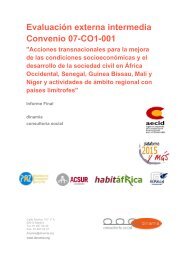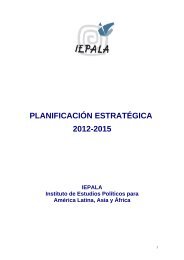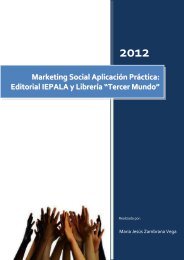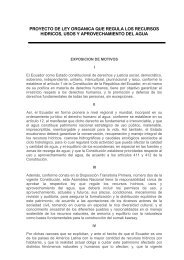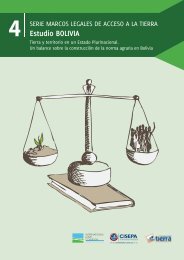<strong>Decentralization</strong> <strong>in</strong> <strong>Sierra</strong> <strong>Leone</strong>contracts with external agencies; c) ensure the proper collection of local revenues; d) approvethe appo<strong>in</strong>tment of chiefdom employees; e) draft bye-laws <strong>for</strong> consideration by the ChiefdomCouncil; f) advise the Chiefdom Council generally on local affairs and per<strong>for</strong>m any otherduties delegated to it by the Chiefdom Council.The chiefdoms were never very effective <strong>in</strong> the service delivery role, not least because mostof their revenues were absorbed by paramount chiefs’ salaries (Kilson, 1966). In 1954, manyof the chiefdoms’ service responsibilities were taken over by the district councils(Zwanikken, et al, 1994) and were not returned when the latter were de-activated <strong>in</strong> 1972. Inany case, a study carried out <strong>in</strong> Kenema District the late 1960s found that ChiefdomCommittees were rarely meet<strong>in</strong>g more than once a year (Barrows, 1971). By the 1970s,section chiefs had taken the place of ward representatives on most Chiefdom Committees andthe Chiefdom Council had devolved <strong>in</strong>to an electoral college <strong>for</strong> paramount chiefta<strong>in</strong>cyelections. Its non-chief members were usually appo<strong>in</strong>ted from above rather than elected bytaxpayers (Fanthorpe and Sesay, 2009). The decl<strong>in</strong>e of government-led economic <strong>in</strong>vestment<strong>in</strong> the prov<strong>in</strong>ces dur<strong>in</strong>g this period, and the assertion of central control over chiefdomf<strong>in</strong>ancial adm<strong>in</strong>istration (see note 1 above), only served to hasten the de-<strong>for</strong>malization ofchiefdom governance.Today, most lower-rank<strong>in</strong>g chiefs rema<strong>in</strong> socially embedded, presid<strong>in</strong>g over the day-to-dayaffairs of their villages and neighbourhoods. Meanwhile, paramount chiefs have arrogated tothemselves the executive and adm<strong>in</strong>istrative powers that, by law, are <strong>in</strong>vested <strong>in</strong> theChiefdom Council and Committee. The result<strong>in</strong>g lack of accountability <strong>in</strong> chiefdomgovernance lies at the root of the numerous grievances that cont<strong>in</strong>ue to be voiced <strong>in</strong> NGO-led<strong>for</strong>ums: e.g. exorbitant f<strong>in</strong>es handed down <strong>in</strong> the local courts and chiefs’ <strong>in</strong><strong>for</strong>mal courts, thetendency of paramount chiefs to broker deals with m<strong>in</strong><strong>in</strong>g, logg<strong>in</strong>g and agri-bus<strong>in</strong>essenterprises without properly consult<strong>in</strong>g local landowners or secur<strong>in</strong>g adequate communitycompensation and the tendency of chiefs and chiefdom staff to demand ad hoc fees <strong>for</strong>services <strong>in</strong> addition to collect<strong>in</strong>g <strong>for</strong>mal taxes <strong>for</strong> these services (Fanthorpe, 2004b;Fanthorpe and Sesay, 2009; MCSL, 2009). Early predictions of the demise of chiefta<strong>in</strong>cy <strong>in</strong><strong>Sierra</strong> <strong>Leone</strong> have proven to be premature, but the case <strong>for</strong> <strong>in</strong>stitutional re<strong>for</strong>m at this level isstronger than ever.Clearly, the LGA should have gone much further to ensure that obsolete legislation wasrepealed and that local councils had genu<strong>in</strong>e authority to carry out their mandates. None ofthe chiefdoms’ residual functions <strong>in</strong> respect of revenue collection, service management,plann<strong>in</strong>g, contract<strong>in</strong>g and environmental regulation can reasonably be described as“traditional”. Accord<strong>in</strong>gly, there is no reason <strong>in</strong> pr<strong>in</strong>ciple why all such functions could not betransferred to the local councils. <strong>Sierra</strong> <strong>Leone</strong> could have taken a lead here from otherAfrican countries and removed all executive powers from chiefs. <strong>Sierra</strong> <strong>Leone</strong> could havetaken a lead from other African countries and removed all executive powers from chiefs. Forexample, Section 246(f) of the Constitution of Uganda (1995) states explicitly that: “atraditional leader or cultural leader shall not have or exercise any adm<strong>in</strong>istrative, legislativeor executive powers of government or local government.” In Ghana also, successivegovernments have taken measures to ensure that chiefta<strong>in</strong>cy operates with<strong>in</strong> the conf<strong>in</strong>es ofto civil society, however <strong>in</strong>fluential chiefs may rema<strong>in</strong> <strong>in</strong> national politics (Boafo-Arthur,2001; Crook, 2005). However, <strong>Sierra</strong> <strong>Leone</strong> has <strong>in</strong>stead conserved two compet<strong>in</strong>g spheres oflocal authority, each hold<strong>in</strong>g resources and capacities the other needs to govern effectively.Fanthorpe Consultancy Ltd Page 59
<strong>Decentralization</strong> <strong>in</strong> <strong>Sierra</strong> <strong>Leone</strong>Institutional Choice <strong>in</strong> Local GovernmentThere has been talk <strong>in</strong> GoSL circles <strong>for</strong> several years about the need to revise and expand theLGA, but the ma<strong>in</strong> constra<strong>in</strong>ts on the development of an effective local government system <strong>in</strong><strong>Sierra</strong> <strong>Leone</strong> are political rather than technical. Chiefta<strong>in</strong>cy has long been noted <strong>in</strong> theliterature as the national elite’s <strong>in</strong>strument of choice <strong>for</strong> ma<strong>in</strong>ta<strong>in</strong><strong>in</strong>g political control over thecountryside and <strong>for</strong> mobiliz<strong>in</strong>g the rural vote at election time (e.g. Kilson, 1966; Barrows,1976; Reno 1995; Rob<strong>in</strong>son, 2010). This strategy reflects the state topography <strong>Sierra</strong> <strong>Leone</strong><strong>in</strong>herited at Independence. Freetown was already a thriv<strong>in</strong>g port city with 30,000 <strong>in</strong>habitants,its own municipal council and an extensive trad<strong>in</strong>g h<strong>in</strong>terland when the Protectorate wascreated <strong>in</strong> 1896 (Banton, 1957). Economic <strong>in</strong>vestment <strong>in</strong> the Protectorate never approachedthe levels the colonial authorities had orig<strong>in</strong>ally been hop<strong>in</strong>g <strong>for</strong>. At Independence, Freetownwas firmly established as a primate city while the ma<strong>in</strong> economic activity <strong>in</strong> the <strong>for</strong>merProtectorate (i.e. the prov<strong>in</strong>ces) rema<strong>in</strong>ed smallholder farm<strong>in</strong>g. Little has changed s<strong>in</strong>ce then.Accord<strong>in</strong>g to the 2004 census, 15½ per cent of <strong>Sierra</strong> <strong>Leone</strong>’s population and more than 80per cent of its public sector workers are located <strong>in</strong> Freetown.This topography has always encouraged political identification with prov<strong>in</strong>cial localities,especially chiefdoms, and a popular view of the state as a resource to be harnessed <strong>in</strong> the<strong>in</strong>terest of these localities. Competition between local groups to access state resources,<strong>in</strong>clud<strong>in</strong>g scarce educational and work opportunities, created a demand <strong>for</strong> patrons: an elitewith sufficient education and professional tra<strong>in</strong><strong>in</strong>g to operate successfully <strong>in</strong> government, yetrema<strong>in</strong><strong>in</strong>g loyal to its communities of orig<strong>in</strong>. Chiefs were early <strong>in</strong>vestors <strong>in</strong> the colonialeducation system and the founder members of the SLPP, <strong>Sierra</strong> <strong>Leone</strong>’s first party ofgovernment, were all members of chiefly families. The extension of universal suffrage <strong>in</strong>tothe prov<strong>in</strong>ces <strong>in</strong> the 1950s gave them a decisive electoral advantage over the Krio elite of theold Colony. For them, descent from “natural” African rulers was emblematic of their right torule an <strong>in</strong>dependent <strong>Sierra</strong> <strong>Leone</strong> (Kilson, 1966; Cartwright 1970). Hav<strong>in</strong>g won power as asocial elite, early SLPP leaders had little <strong>in</strong>terest <strong>in</strong> build<strong>in</strong>g bureaucratic capacity <strong>in</strong> thecountryside. By their calculation, such developments would merely create plat<strong>for</strong>ms <strong>for</strong>challengers to their local pre-em<strong>in</strong>ence (Cartwright, 1970). Even the socialist-lean<strong>in</strong>g APC,which drew its early support from petty traders, commercial employees and lower paidgovernment workers, found it politically expedient to cultivate alliances with chiefdom rul<strong>in</strong>ghouses.The trad<strong>in</strong>g of promises of government patronage <strong>for</strong> (actual or prospective) subjects’ votesensured the thorough imbrication of chiefta<strong>in</strong>cy politics and party politics. This process ledmany commentators to argue that <strong>Sierra</strong> <strong>Leone</strong> underwent a remarkably seamless transitionfrom colonial “<strong>in</strong>direct rule” to the <strong>in</strong>direct participation of the rural masses <strong>in</strong> moderndemocracy (Kilson, 1966; Cartwright, 1970; M<strong>in</strong>ik<strong>in</strong>, 1973; Barrows, 1976; Clapham, 1976;Tangri 1978b). However, the rural masses were not always passive pawns <strong>in</strong> these politicalgames. For example, it was not unknown <strong>for</strong> MPs of the early 1960s to lose their seats if theyfailed, dur<strong>in</strong>g election campaigns, to visit off-road villages <strong>in</strong> their constituencies and engage<strong>in</strong> traditional “shake hands” (i.e. gift giv<strong>in</strong>g) with local headmen (Cartwright, 1970). In thefollow<strong>in</strong>g decade, the Siaka Stevens regime’s tendency to confer paramount chiefta<strong>in</strong>cies onparty loyalists regardless of their “rul<strong>in</strong>g house” credentials often generated prolonged localprotest and campaigns of civil disobedience (Reno, 1995; Fanthorpe, 2006).The political impact of these protests was nevertheless limited by their localization.Furthermore, both of the lead<strong>in</strong>g parties, when <strong>in</strong> power, took full advantage of theauthoritarian possibilities <strong>in</strong> the colonially-<strong>in</strong>herited apparatus <strong>for</strong> regulat<strong>in</strong>g chiefta<strong>in</strong>cy andFanthorpe Consultancy Ltd Page 60





